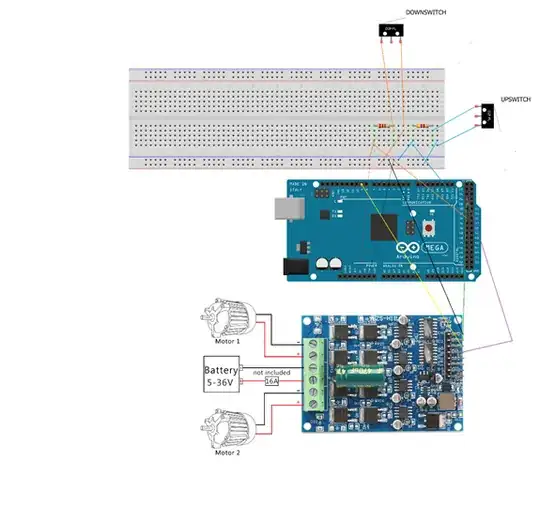I have a circuit connected as follows

my limit switches which are attached to my structure sometimes gets falsely triggered, so I wrote this code to address it. My motor is supposed to go down skip the up limit switch at first hit the down one then go back to the up one. is this a good way to implement it? https://pastebin.com/qVU1Gp0q
//Switch pressed -> reading HIGH
//Switch not pressed -> reading LOW
//Motor direction 0 is down, 1 is up
const int uplimit = 32;
const int downlimit = 34;
const int motorspeed = 9;
const int motordirection = 28;
//const int pumpspeed=5;
//const int pumpdirection=6;
const int motorenable = 26;
//const int pumpenable=;
int Finishedcleaning = 0;
int Reachedup = 0;
int Motorinitialsetup = 0;
int Motorsecondsetup = 0;
int downfiltered = 0;
int upfiltered = 0;
void setup() {
// put your setup code here, to run once:
pinMode(motorspeed, OUTPUT);
pinMode(motordirection, OUTPUT);
pinMode(motorenable, OUTPUT);
//pinMode(pumpspeed, OUTPUT);
//pinMode(pumpenable, OUTPUT);
pinMode(uplimit, INPUT);
pinMode(downlimit, INPUT);
}
void loop() {
// put your main code here, to run repeatedly:
int average1 = 0;
int average2 = 0;
if (Motorinitialsetup == 0 ) // to be run before hitting initial switch
{ digitalWrite(motorenable, HIGH);
analogWrite(motorspeed, 190);
digitalWrite(motordirection, 0); // Bring motor down
// digitalWrite(pumpenable,HIGH);
// digitalWrite(pumpdirection,1);
// analogWrite(pumpspeed,240);
Motorinitialsetup = 1; //so this if statement does not run again
}
for (int i = 1; i < 100; i++)
{ downfiltered = digitalRead(downlimit);
average1 = average1 + downfiltered;
}
average1 = average1 / 100;
if ((average1 > 0.9) && Finishedcleaning == 0 ) // Function after hitting down switch
{
delay(1000); // wait until motor cross switch
analogWrite(motorspeed, 0); // stop motor
Finishedcleaning = 1; //indicate cleaning is over for next loop
delay(500); // wait until motor cross switch
}
if ( (Finishedcleaning == 1) && (Reachedup == 0) && (Motorsecondsetup == 0))
{
digitalWrite(motordirection, 1); // reverse motor direction
analogWrite(motorspeed, 190); // start motor again
Motorsecondsetup = 1;
}
if ( Motorsecondsetup == 1) // only checks switch up switch after motors comes back
{
for (int i = 1; i < 300; i++)
{ upfiltered = digitalRead(downlimit);
average2 = average2 + downfiltered;
}
average2 = average2 / 300;
if ((average2 > 0.9) && (Finishedcleaning == 1)) // Stop Motor after returning
{ analogWrite(motorspeed, 0);
delay(1000);
Reachedup = 1; // indicate finished returning after cleaning cycle
}
}
}